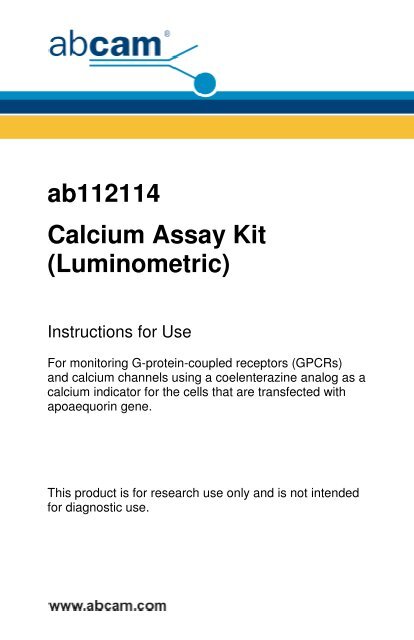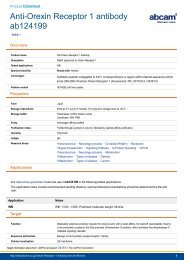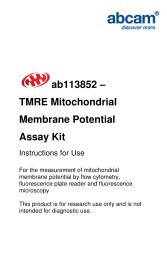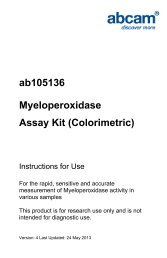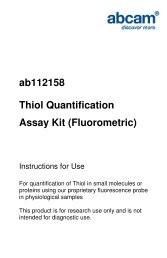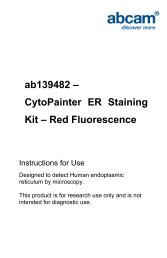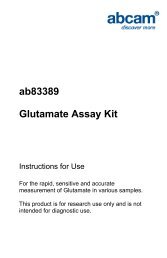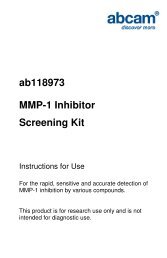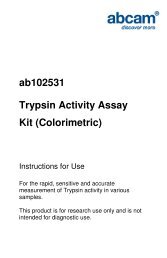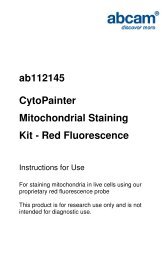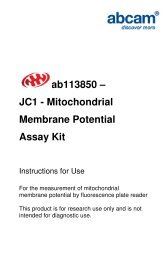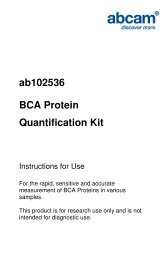ab112114 Calcium Assay Kit (Luminometric) - Abcam
ab112114 Calcium Assay Kit (Luminometric) - Abcam
ab112114 Calcium Assay Kit (Luminometric) - Abcam
You also want an ePaper? Increase the reach of your titles
YUMPU automatically turns print PDFs into web optimized ePapers that Google loves.
<strong>ab112114</strong> <strong>Calcium</strong> <strong>Assay</strong> <strong>Kit</strong> -<strong>Luminometric</strong>Table of Contents1. Introduction 32. Protocol Summary 53. <strong>Kit</strong> Contents 64. Additional Materials Required 65. Storage and Handling 66. <strong>Assay</strong> Protocol 77. Data Analysis 108. Troubleshooting 112
1. Introduction<strong>ab112114</strong> <strong>Calcium</strong> <strong>Assay</strong> <strong>Kit</strong> -<strong>Luminometric</strong><strong>Calcium</strong> flux assays are preferred methods in drug discovery forscreening G protein coupled receptors (GPCR). This kit uses ahighly calcium-sensitive and membrane-permeable coelenterazineanalog as a calcium indicator for the cells that are transfected withapoaequorin gene. Aequorin is a calcium-sensitive bioluminescentprotein from the jellyfish Aequorea victoria that has been usedextensively as a calcium indicator in cells. The aequorin complexemits blue light when bound to calcium ions. The luminescenceintensity is directly proportional to the Ca 2+ concentration.<strong>ab112114</strong> <strong>Calcium</strong> <strong>Assay</strong> <strong>Kit</strong> – <strong>Luminometric</strong> is much more sensitivethan the fluorescence-based calcium assays. This kit provides anoptimized assay method for monitoring the G-protein-coupledreceptors and calcium channels. The assay can be performed in aconvenient 96-well or 384-well microtiter-plate format and easilyadapted to automation. It might be useful for monitoring theintracellular calcium mobilization in a specified compartment giventhat recombinant apoaequorin proteins can now be targeted tospecific organelles, cells and tissues. <strong>ab112114</strong> is more sensitivethan the fluorescent calcium assays.3
<strong>Kit</strong> Key Features<strong>ab112114</strong> <strong>Calcium</strong> <strong>Assay</strong> <strong>Kit</strong> -<strong>Luminometric</strong>• Increased S/B Ratio: High signal to background ratio withvery low luminescence background.• Convenient: Formulated to have minimal hands-on time. Nowash step needed.• Versatile Applications: Compatible with many cell lines andtargets without ligand or target interference.4
<strong>ab112114</strong> <strong>Calcium</strong> <strong>Assay</strong> <strong>Kit</strong> -<strong>Luminometric</strong>2. Protocol SummarySummary for One 96-well Plate..Prepare cellsRemove growth mediumAdd coelenterazine-loading solution(100 µL /well/96-well plate or25 µL/well/384-well plate)Incubate at room temperature for 3 - 4 hours.Monitor aequorin luminescence intensityNote: Thaw all the kit components to room temperature beforestarting the experiment.5
3. <strong>Kit</strong> Contents<strong>ab112114</strong> <strong>Calcium</strong> <strong>Assay</strong> <strong>Kit</strong> -<strong>Luminometric</strong>ComponentsAmountComponent A: Coelenterazine Analog1 vial (lyophilized)Component B: 100% ETOH 1 x 500 µLComponent C: <strong>Assay</strong> Buffer100 mL (1X ready to use)4. Additional Materials Required• 96 or 384 – well microplates: Tissue culture microplateswith white wall and clear bottom• Luminecence microplate reader• HHBS (1X Hank’s with 20 mM Hepes Buffer, pH 7.0)5. Storage and HandlingKeep at -20°C. Avoid exposure to light.6
<strong>ab112114</strong> <strong>Calcium</strong> <strong>Assay</strong> <strong>Kit</strong> -<strong>Luminometric</strong>6. <strong>Assay</strong> ProtocolNote: This protocol is for one 96 - well plate.A. Prepare Cells1. For adherent cells: Plate cells overnight in growthmedium at 40,000 to 80,000 cells/well/100 µL for a 96-well plate or 10,000 to 20,000 cells/well/25 µL for a 384-well plate.2. For non-adherent cells: Centrifuge the cells from theculture medium and then suspend the cell pellet in thecoelenterazine - loading solution (see section 2, step 4)at 125,000 to 250,000 cells/well/100 µL for a 96-wellpoly- D lysine plate or 30,000 to 60,000 cells/well/25 µLfor a 384-well poly-D lysine plate. Centrifuge the plate at800 rpm for 2 minutes with brake off prior to theexperiments.Note: Each cell line should be evaluated on theindividual basis to determine the optimal cell density forthe intracellular calcium mobilization7
<strong>ab112114</strong> <strong>Calcium</strong> <strong>Assay</strong> <strong>Kit</strong> -<strong>Luminometric</strong>B. Prepare coelenterazine - loading solution1. Thaw all the kit components at room temperaturebefore use.2. Make coelenterazine analog: Add 250 µL of 100%ETOH (Component B) into the vial of CoelenterazineAnalog (Component A), and mix them well.Note: 25 µL of reconstituted coelenterazine analog isenough for one plate. Unused coelenterazine analogstock solution can be stored at ≤ -20 o C for more thanone month if the tubes are sealed tightly. Protect fromlight and avoid repeated freeze-thaw cycles.3. Make 1X assay buffer: Ready to use 1X <strong>Assay</strong> Buffer(Component C) supplied.Note: 10 mL of 1X assay buffer is enough for one plate.Store unused 1X assay buffer at 4 o C.4. Make coelenterazine - loading solution for one cellplate: Add 25 µL of ETOH reconstituted coelenterazineanalog (from Step 2) into 10 mL of 1X assay buffer(from Step 3), and mix them well. This working solutionis stable for at least 2 hours at room temperature,protected from light.8
<strong>ab112114</strong> <strong>Calcium</strong> <strong>Assay</strong> <strong>Kit</strong> -<strong>Luminometric</strong>C. Run <strong>Calcium</strong> <strong>Assay</strong>:1. Remove the growth medium from the cell plates.Note 1: It is important to remove the growth medium inorder to minimize compound interference with serum orculture media.Note 2: Alternatively, grow the cells in growth mediumwith 0.5 - 1% FBS to avoid medium removal step. In thiscase, 2X coelenterazine- loading solution in 1X assaybuffer is needed.2. Add 100 µL/well (96-well plate) or 25 µL/well (384-wellplate) coelenterazine loading solution (from section B,step 4) into the cell plates3. Incubate the coelenterazine - loading plates at roomtemperature for 3 - 4 hours, protected from light4. Prepare the compound plates with HHBS or the desiredbuffer.5. Monitor the aequorin luminescence intensity by usingthe photon detection system that has an enclosedchamber containing a photomultiplier. The instrumentmust completely exclude outside light.9
<strong>ab112114</strong> <strong>Calcium</strong> <strong>Assay</strong> <strong>Kit</strong> -<strong>Luminometric</strong>7. Data AnalysisFigure 1. ATP Dose Response on CHO-aeq cells. CHO cells stablytransfected with apoaequrin were seeded overnight at 50,000cells/100 µL/well in a white wall/clear bottom 96-well plate. Thegrowth medium was removed and the cells were incubated with100 µL of dye-loading solution using the <strong>ab112114</strong> for 3 hours atroom temperature and protected from light. ATP (25 µL/well) wasadded to achieve the final indicated concentrations. The EC 50 of ATPis about 0.8 µM.10
<strong>ab112114</strong> <strong>Calcium</strong> <strong>Assay</strong> <strong>Kit</strong> -<strong>Luminometric</strong>8. TroubleshootingProblem Reason Solution<strong>Assay</strong> notworkingUnexpectedresults<strong>Assay</strong> buffer atwrong temperatureProtocol step missedPlate read atincorrect wavelengthUnsuitable microtiterplate for assayMeasured at wrongwavelengthSamples containimpeding substancesUnsuitable sampletypeSample readings areoutside linear range<strong>Assay</strong> buffer must not be chilled- needs to be at RTRe-read and follow the protocolexactlyEnsure you are usingappropriate reader and filtersettings (refer to datasheet)Fluorescence: Black plates(clear bottoms);Luminescence: White plates;Colorimetry: Clear plates.If critical, datasheet will indicatewhether to use flat- or U-shapedwellsUse appropriate reader and filtersettings described in datasheetTroubleshoot and also considerdeproteinizing samplesUse recommended samplestypes as listed on the datasheetConcentrate/ dilute samples tobe in linear range11
<strong>ab112114</strong> <strong>Calcium</strong> <strong>Assay</strong> <strong>Kit</strong> -<strong>Luminometric</strong>SampleswithinconsistentreadingsLower/Higherreadings insamplesandstandardsUnsuitable sampletypeSamples prepared inthe wrong bufferSamples notdeproteinized (ifindicated ondatasheet)Cell/ tissue samplesnot sufficientlyhomogenizedToo many freezethawcyclesSamples containimpeding substancesSamples are too oldor incorrectly storedNot fully thawed kitcomponentsOut-of-date kit orincorrectly storedreagentsReagents sitting forextended periods oniceIncorrect incubationtime/ temperatureIncorrect amountsusedRefer to datasheet for detailsabout incompatible samplesUse the assay buffer provided(or refer to datasheet forinstructions)Use the 10kDa spin column(ab93349) or Deproteinizingsample preparation kit(ab93299)Increase sonication time/number of strokes with theDounce homogenizerAliquot samples to reduce thenumber of freeze-thaw cyclesTroubleshoot and also considerdeproteinizing samplesUse freshly made samples andstore at recommendedtemperature until useWait for components to thawcompletely and gently mix prioruseAlways check expiry date andstore kit components asrecommended on the datasheetTry to prepare a fresh reactionmix prior to each useRefer to datasheet forrecommended incubation timeand/ or temperatureCheck pipette is calibratedcorrectly (always use smallestvolume pipette that can pipetteentire volume)12
<strong>ab112114</strong> <strong>Calcium</strong> <strong>Assay</strong> <strong>Kit</strong> -<strong>Luminometric</strong>Problem Reason SolutionStandardcurve is notlinearNot fully thawed kitcomponentsPipetting errors whensetting up thestandard curveIncorrect pipettingwhen preparing thereaction mixAir bubbles in wellsConcentration ofstandard stockincorrectErrors in standardcurve calculationsUse of otherreagents than thoseprovided with the kitWait for components to thawcompletely and gently mix prioruseTry not to pipette too smallvolumesAlways prepare a master mixAir bubbles will interfere withreadings; try to avoid producingair bubbles and always removebubbles prior to reading platesRecheck datasheet forrecommended concentrations ofstandard stocksRefer to datasheet and re-checkthe calculationsUse fresh components from thesame kitFor further technical questions please do not hesitate tocontact us by email (technical@abcam.com) or phone (select“contact us” on www.abcam.com for the phone number foryour region).13
<strong>ab112114</strong> <strong>Calcium</strong> <strong>Assay</strong> <strong>Kit</strong> -<strong>Luminometric</strong>14
<strong>ab112114</strong> <strong>Calcium</strong> <strong>Assay</strong> <strong>Kit</strong> -<strong>Luminometric</strong><strong>Abcam</strong> in the USA<strong>Abcam</strong> in Japan<strong>Abcam</strong> Inc<strong>Abcam</strong> KK1 Kendall Square, Ste B2304 1-16-8 NihonbashiCambridge,Kakigaracho,MA 02139-1517Chuo-ku, TokyoUSA 103-0014JapanToll free: 888-77-ABCAM (22226)Fax: 866-739-9884 Tel: +81-(0)3-6231-094Fax: +81-(0)3-6231-0941<strong>Abcam</strong> in Europe<strong>Abcam</strong> in Hong Kong<strong>Abcam</strong> plc<strong>Abcam</strong> (Hong Kong) Ltd330 Cambridge Science Park Unit 225A & 225B, 2/FCambridge Core Building 2CB4 0FL1 Science Park West AvenueUKHong Kong Science ParkHong KongTel: +44 (0)1223 696000Fax: +44 (0)1223 771600 Tel: (852) 2603-682Fax: (852) 3016-188815Copyright © 2011 <strong>Abcam</strong>, All Rights Reserved. The <strong>Abcam</strong> logo is a registered trademark.All information / detail is correct at time of going to print.


